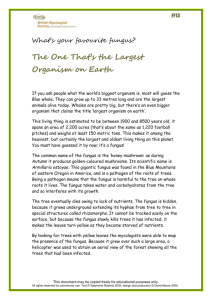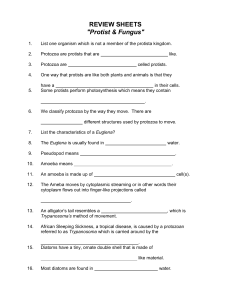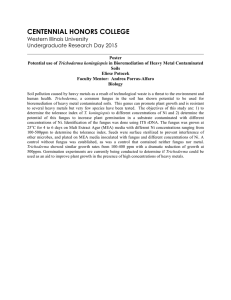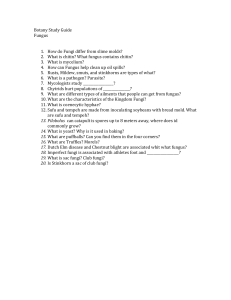Document 11113682
advertisement
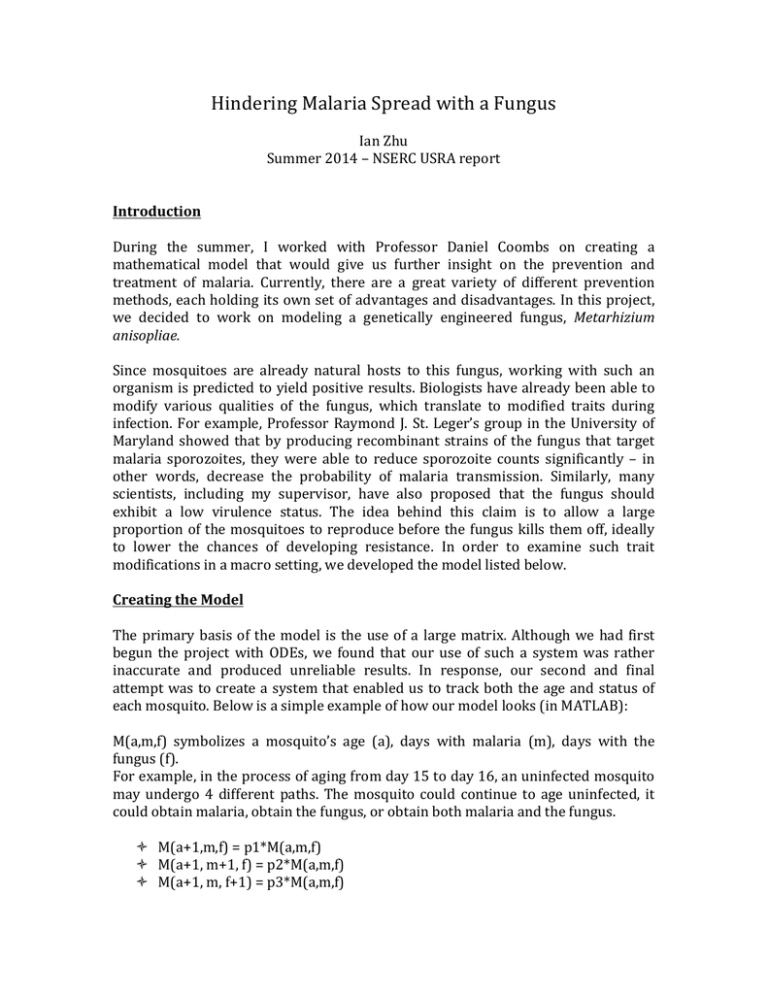
Hindering Malaria Spread with a Fungus Ian Zhu Summer 2014 – NSERC USRA report Introduction During the summer, I worked with Professor Daniel Coombs on creating a mathematical model that would give us further insight on the prevention and treatment of malaria. Currently, there are a great variety of different prevention methods, each holding its own set of advantages and disadvantages. In this project, we decided to work on modeling a genetically engineered fungus, Metarhizium anisopliae. Since mosquitoes are already natural hosts to this fungus, working with such an organism is predicted to yield positive results. Biologists have already been able to modify various qualities of the fungus, which translate to modified traits during infection. For example, Professor Raymond J. St. Leger’s group in the University of Maryland showed that by producing recombinant strains of the fungus that target malaria sporozoites, they were able to reduce sporozoite counts significantly – in other words, decrease the probability of malaria transmission. Similarly, many scientists, including my supervisor, have also proposed that the fungus should exhibit a low virulence status. The idea behind this claim is to allow a large proportion of the mosquitoes to reproduce before the fungus kills them off, ideally to lower the chances of developing resistance. In order to examine such trait modifications in a macro setting, we developed the model listed below. Creating the Model The primary basis of the model is the use of a large matrix. Although we had first begun the project with ODEs, we found that our use of such a system was rather inaccurate and produced unreliable results. In response, our second and final attempt was to create a system that enabled us to track both the age and status of each mosquito. Below is a simple example of how our model looks (in MATLAB): M(a,m,f) symbolizes a mosquito’s age (a), days with malaria (m), days with the fungus (f). For example, in the process of aging from day 15 to day 16, an uninfected mosquito may undergo 4 different paths. The mosquito could continue to age uninfected, it could obtain malaria, obtain the fungus, or obtain both malaria and the fungus. ! M(a+1,m,f) = p1*M(a,m,f) ! M(a+1, m+1, f) = p2*M(a,m,f) ! M(a+1, m, f+1) = p3*M(a,m,f) ! M(a+1, m+1, f+1) = p4*M(a,m,f) (in the case above, m and f would be 0, symbolizing a mosquito that has not yet obtained malaria or fungus. Obtaining it would launch the values into m=f=1, which would then bring the mosquitoes into a system where every day the m and f values would increase by 1, to symbolize the number of days that the mosquito has had the fungus/malaria) We then created a similar matrix system for humans, and allowed this matrix system to interact with the mosquito system. Therefore, we were able to obtain results by looking at malaria prevalence within the human population. Results Although our results may not be quantitatively accurate, they provide us a great qualitative picture of what may or may not be effective in reducing the burden of malaria. For example, at the start of the project, my supervisor proposed that we looked at the vertical transmission of the fungus. Although such a quality has not yet been genetically engineered, the idea stems from a variety of other natural parasites that are able to vertically transmit themselves. After running the model and looking at malaria prevalence in humans, we concluded that vertical transmission might only be effective if constant fungus spraying is implemented. Since we assume the fungus itself decays at an exponential rate, the initial quantity of fungus decreases significantly over time. Our results show that vertical transmission is not effective at preserving the fungus in the long run. However, if constant spraying is used, where the fungus load is restored continuously in time, the vertical transmission becomes beneficial in combating malaria. Final Comments The project was a lot of fun, since it was my first stab at independent research. My supervisor consistently encouraged me to focus on the things I was interested in, and gave me guidance only when I needed it. Unlike some of the other projects, the work that I did over summer was mostly unprecedented, thus giving me the opportunity to solve my own problems and come up with my own ideas. All in all, it was a great learning experience.
